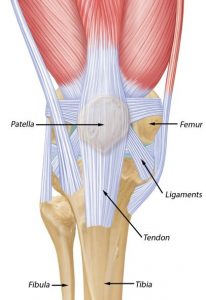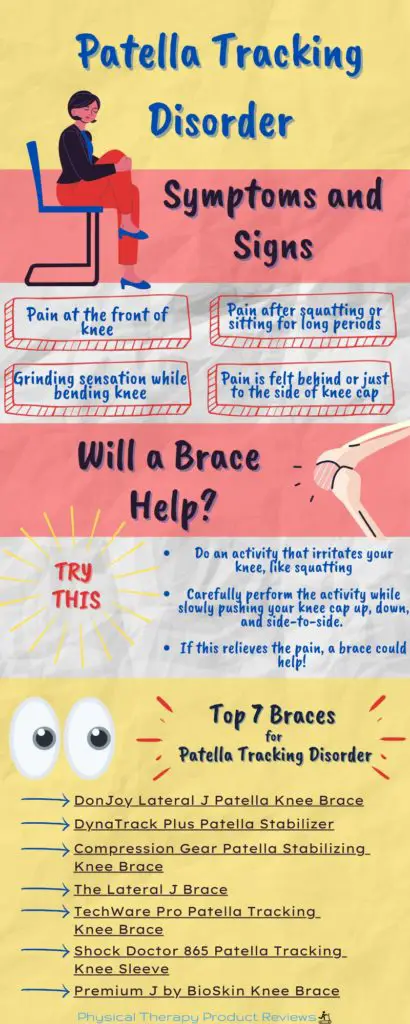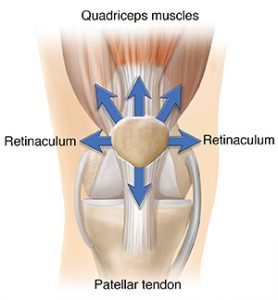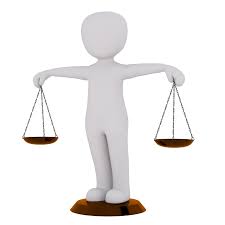What is Patellar Tracking disorder?
![]() Patella tracking, even though it may seem like a simple thing, is a very complex process. The patella (knee cap) moves up and down the end of the femur when we bend and straighten our knees. While the knee is bending and/or straightening there are numerous muscles, tendons, boney alignment, and ligaments that help stabilize the kneecap in the correct position. The kneecap is essentially floating on the end of our femur just waiting to pulled in about 100 different directions at once!
Patella tracking, even though it may seem like a simple thing, is a very complex process. The patella (knee cap) moves up and down the end of the femur when we bend and straighten our knees. While the knee is bending and/or straightening there are numerous muscles, tendons, boney alignment, and ligaments that help stabilize the kneecap in the correct position. The kneecap is essentially floating on the end of our femur just waiting to pulled in about 100 different directions at once!
Patella tracking disorder can occur when the forces that stabilize the kneecap become unbalanced. This may cause the kneecap to shift towards the inside or the outside of the knee and cause unnecessary pain. This patella misalignment with repetitive motion over time can cause knee pain over the front, underside, inside, or outside of the kneecap depending on the direction of the shift. There are many different names or diagnosis that are related to a Patella Tracking Disorder including Chondromalacia Patella, Patellofemoral Disorder, and/or sometimes even IT Band Syndrome. Often times the pain with these disorders isn’t necessarily severe but is enough to stop you from doing the things you enjoy doing.
Comparing Knee Braces for Patella Tracking Dysfunction
| Name | Picture | Price | Best Feature | Our rating | Best Price |
|---|---|---|---|---|---|
| DonJoy Lateral J Patella Knee Brace Review |
 |
$$ | We love the Drytex material and adjustable support | 9.7/10 | See Current Price |
| DynaTrack Plus Patella Stabilizer |
 |
$ | Really Easy to Take On and Off | 9.5/10 | See Current Price |
| Compression Gear Patella Stabilizing Knee Brace |
 |
$ | Lightweight and minimal design | 9.3/10 | See Current Price |
| BraceAbility J Patella Knee Brace |
 |
$$ | Fits either leg with great patella support | 9.6/10 | See Current Price |
| TechWare Pro Knee Brace |
 |
$ | Minimal design but good support | 9.2/10 | See Current Price |
| Shock Doctor Patella Tracking Knee Brace |
 |
$ | Comfortable once it's on, good patella control | 9.5/10 | See Current Price |
| BIOSKIN Lateral J Knee Brace |
 |
$$$ | Maximum patella support | 9.6/10 | See Current Price |
Anatomy of the Knee Joint

To better help with understanding the different patella tracking disorders it helps to look at the anatomy of the knee joint. The primary joint contains the Femur (thigh bone) and Tibia (shin bone). This joint has two compartments, the medial (inside of the knee) and lateral (outside of the knee) aspects. Finally, the patella sits on top of the thigh bone and acts as a fulcrum for your quad muscles. Without your knee cap the big strong quad muscle wouldn’t have the advantage and strength to help us run, lunge, or jump. The patella slides within the groove on the thigh bone when you straighten and bend the knee and is held in place by ligaments and tendons.
What Causes Patellar Tracking Issues
Patella tracking and anterior knee pain is often not caused by one specific issue. There are many different factors that can affect the knee cap position including:
- Weakness in the quads and hips
- Overuse or sudden increase in activity
- Sitting for extended periods of time with the knee bent
- Any imbalance of pulls from tendons, muscles, or ligaments
- General unique anatomy differences specific to that leg
It can also be caused by trauma such as falling on the kneecap itself or getting hit in the knee during a sporting event. It’s not uncommon to occur after minor surgeries or contusion the thigh as both of these events tend to inhibit or turn off the quads muscles. The quads account for nearly 40% of our knee stability and are the most important stabilizer of our knee cap.
What is Normal Patella Tracking and Why Does it Matter?
Patellar tracking is not something that we normally think about until it’s gone wrong. Why do we notice it when it becomes abnormal? Well because of PAIN! However pain isn’t the only issue we should be worried about when our knee cap starts screaming?
Normally, the patella has a lot of differences forces upon it. There are ligaments trying to stabilize it and then there are tendons and muscles pulling the knee cap every which way, best demonstrated from the picture.
The knee cap wants to be in constant homeostasis. To simply things an analogy often used is the that the knee cap is a train and the femur or Trochlear groove is the train tracks. When the train gets of track there is potential for something to go wrong, right? Well normally the body does a great job regulating the forces on the knee cap, but every so often the forces become too great and Patella Tracking Disorder occurs or the various different names associated with it.

Chondromalacia Patella
Chondromalacia patella is simply another name for Patella Tracking, even though it shouldn’t be used that way in medicine. Not only does pain occur but just as important is that high levels of pain can cause quad strength to decrease! This is really important. Our quads are responsible for keeping us upright, keeping us standing, help us go up stairs. They are one of the largest muscle groups in our body.
Now imagine that they are working at only 75% of normal because of pain and tracking? Yet we can’t tell (very easily) that they aren’t firing at full capacity.
This is why injury rates in other joints on the same side of the body are so common such as the ankle or the hip. This also may cause what can be described as the “knee giving out.” We’ve all had that feeling when we go to take a step, only nothing is there and our leg collapses for no good reason? This is much more common when the quads are effected from improper tracking.

What Are The Symptoms of Patella Tracking Disorder and Will A Brace Help?
There are a multitude of symptoms that could indicate you have patellar tracking disorder. Pain experienced at the front of the knee during physical activity is a strong indicator. Pain with repetitive knee bending, frontal knee pain with squatting or sitting for a long period of time, or a grinding sensation that is painful during movement. The pain is often located behind or sometimes on the outsides of the knee cap. If it is below the knee cap, closer to the shin, you may have patellar tendinitis or tendinosis.
The first thing to do is stop the activities that make it worse and give the knee a break. For some of you that’s not an option so altering the knee cap tracking by using a brace will allow you continue biking, running, and playing sports with less pain. To see if a brace would help try the following sequence:
Provocative Testing:
- Find an activities that aggravates your symptoms, note how it feels. For example slow stepping down the stairs or a single leg squat.
- Perform that activity again but with you or someone you trust pushing your knee cap in different directions including: up, down, towards the other leg, and outwards
- If the pain is relieved with altering the knee cap location a brace may help with pain and kelp you keep your activity levels
Why Does Patellofemoral Dysfunction Cause Pain?
The pain presentation with Patellofemoral Dysfunction and the related patella tracking disorders is abnormal as compared to the pain processes in the rest of the body. The pain will usually be non-specific, meaning it’s generally on the inside or outside of the knee but the point specific location may change. The simplest and best way to look at PatelloFemoral Dysfunction is to use the thinking of a scale.

One side of the scale is forces produced and on the side is our bodies ability to translate or spread the load out evenly. Therefore if one side of the scale of off then the other side may be off too. Our knees love homeostasis, or staying in a comfortable range. As an example if there is an activity that unexpectedly causes too much load on the knee cap such as running a marathon without ever training that might tip the scale drastically.
When the knee cap can no longer transfer load correctly this causes the body to sound the alarm to make the body stop, it signals pain. Over the years of research we have found the that structures most likely responsible for signaling pain are the fat pad directly behind the knee cap and the surrounding tissue called the capsule.
This is why bracing might help, it helps evenly distribute the load until those structures can calm down and allow you to resume the original activity such as running in this example.
How Long Does Patellofemoral Tracking Disorder Take to Heal?
In most cases, if treated with a proper physical therapy program PFPS will resolve within 6-8 weeks. This does depend on the severity, aggravating factors such as if the person continues to play sports, etc. Some tips to speed up the recovery:
- Discontinue or modifying aggravating factors such as running, jumping, and squatting until symptoms resolve
- Try a tracking brace that can help calm down symptoms
- See a physical therapist that can help educate on a proper rehab program
- Don’t forget to set the body up for success in healing: Get proper sleep, nutrition, exercise.
Need to strengthen the hip but not sure how? Check out our Best Glute and Hip Strengthening Exercises to help protect those knees!
How To Put on a Patella Tracking Brace
What Brace is the Best for Patella Tracking Disorder?
In choosing our list we looked at the braces that would allow you to stay active, play in your game, or let you perform your hobby with the least amount of fuss. For the person that recently suffers a lateral patella dislocation you would likely need more support in the early phases. However these might be a great option as you return back to sport.
Most of the braces are lightweight, easy to use, and provide some sort of support for patella tracking. We tried to keep cost in mind but overall performance and longevity outranked cost.
The majority of the time the kneecap has less pain when positioned more to the inside of the knee but is does vary depending on the person. Therefore, depending on what you find with the provocative testing mention in the previous section one brace will work better for you than others. Some of them only add lateral support pushing the knee cap towards the middle. If your knee feels better with your kneecap pushed towards the inside, then you need a brace that reproduces that. Vice verse if it feels improvement with the knee cap pushed to the outside of the leg.
DonJoy Lateral J Patella Knee Brace Review
Summary: We love this brace. One DonJoy is a leader in all bracing activities. They have great customer support and quality products. For the size this brace is lightweight and can even be used in the water. This brace is intended for those with lateral tracking difficulties such as IT band syndrome or lateral dislocations. The Drytex material allows for improved airflow while still giving ample support and compression. It’s preferred by those in warm weather climates and individuals with neoprene allergies or irritations. This is also designed to fit both men and women!
Pro’s:
- Drytex or Neoprene: Drytex is DonJoy’s exclusive material for anyone with neoprene sensitivities. This also helps decrease the overall heat of the brace. We like the feel of the Drytex personally. The Drytex is made of a nylon and polyester fabric which is primarily designed to allow for improved airflow without sacrificing support. For anyone that lives in warmer climates the Drytex might be better for you.
- With or Without Hinge: One of the coolest features of this brace is the ability to come with a removable hinge. This adds stability but will cost more. For anyone that has suffered previous ligamentous damage (ACL, MCL, PCL, LCL) then you should consider getting the one with the hinge for more rotational stability.
- Tubular “J” Design: The lateral support that helps stabilize the knee cap. This is what helps with the patella tracking and or for any previous dislocation. This is side specific so make sure that you order the correct one for left or right knee
Con’s:
- Seem up the Back: The one complaint that some users have had is the seem on the back side of the brace. Some customers have find that to be uncomfortable and may rub uncomfortably. Check this immediately when ordering.
DynaTrack Plus Patella Stabilizer
Summary: This one of our favorite braces for many reasons. It’s lightweight, pack-able, can be used for both medial and lateral stability needs, comes with a buttress that gives needed force against the patella, and comes with much less bulk than some of the other options. This lets you bend you knee and move more freely with adequate support. Not a lot that we don’t love about this brace other than the slightly higher cost as compared to the sleeves, but for those with true tracking and dislocation history this offers the best of both worlds.
Pro’s:
- C shaped Firm Pad: This brace can be used as both medial and lateral support which handy because you can use it on either leg. This “C” shaped pad provides great support for any patellar tracking issue.
- Wrap Around Design: You can put the brace on without taking of the shoes. You may not realize how nice that this is until you have to continually take your shoes off and on. This means you can put it on under work pants
- Comfortable Design: Lightweight and comfortable design that can provide support without limiting mobility. The neoprene material is comfortable and helps with moisture wicking.
Con’s:
- Durability: However some have complained that they have had to replace it after 6 months of frequent use. This may be dependent on each persons amount of use. If you use it every day 6 months is worth the price, if it’s once a week then that’s a concern. Overall this product has many 5 star reviews on Amazon for a point of reference.
Compression Gear Patella Stabilizing Knee Brace
Summary: This brace is best for those that need less. It’s a brace that offers support with patella support grooves on both sides of the kneecap but comes in on the lighter and more mobile side of braces. This is best for those that don’t have a lot of pain but feel like they just need something extra to keep them doing the things that they love, like running and biking. The single wrap comes in as one of the cheapest on the list and can be used on either leg. It’s also so small that it’s easy to pack in back packs or in the gym bag.
Pro’s:
- Stabilization: Comes with bilateral kneecap supports that provides lateral stabilization of the knee cap.
- Full Compression: The compression sleeve itself is comfortable moisture wicking and has to ability to provide “comfort” in the knee through the compression. The no slip design makes that the brace is comfortable without falling down or out of place.
- Customer Service: There are numerous accounts online of great customer service from the company. If there is any issue at all they will take care of their customers. This is one of our favorite aspects of this brace.
Con’s:
- Strap Smell: A handful of customer accounts have complained of a chemical smell on the straps. This seems to be isolaterd to a handful of braces and not everyone notes this problem.
The BraceAbility Lateral J Brace
Summary: Combines both stability and lighter weight design. It comes with a sleeve and a patellar hole for comfort. The best part of the brace is the lateral buttress that you can adjust the tension to get the best support. The only downside of the brace is that it doesn’t support both medial and lateral if needed but can be work on either leg. One of the absolute best options if you are playing a competitive sport. A great option if you need lateral support.
Pro’s:
- C-shaped Buttress: The C-shaped support and the velcro straps add great support to the kneecap and to the overall knee. For any athlete that dislocates laterally this is an excellent design and brace to return back to sport
- Adjustable Straps: The straps can be pulled as tight or as loose as you want. The straps can also be place high or low depending on the location that feels best or the most supportive.
- High Grade Material: This brace is made of high grade neoprene that is latex free. Neoprene helps with moisture wicking while also limiting irritation of the skin. The material is comfortable to wear and feels soft to the skin.
- Additional Support: The buttress is actually removable and made of molded neoprene. There are spiral stays on the outside of the brace providing total knee support without adding too much weight.
Con’s:
- Measure Carefully: Most of the complaints on this brace come down to sizing issues. Make sure you measure correctly and that the correct size is ordered. It tends to run small
- Durability: Most of the reviews don’t have durability as too much of an issue, however the straps can be pulled off the brace if you are trying to since the brace down too much, again this seems to be more of a sizing issue
TechWare Pro Patella Tracking Knee Brace
Summary: Another lightweight brace that gives support without compromising size and weight. The best part of this brace is the ability to provide both medial and lateral support and the ability to adjust. The downside is not enough support for the person that chronically dislocates their knee cap.
Pro’s:
- Adjustable, Bi-directional: The Techware brace can be as tight or as loose as you want with the adjustable pull system. The design also lets you pull from either direction and can used on either knee. This flexible makes it a favorite among people who need lighter stability.
- Ease of Use: This brace is maybe the easiest to use on the whole list. You do not need to take your shoes off to put on, can be used on either knee, and can fit over pants if needed. It’s also small so it can be transported in a gym bag or even a purse.
- High Grade Material: This brace is made of high grade moisture wicking neoprene that comes with silicone straps. The silicone straps help keep it from slipping on the leg during activity.
- Open Patella: The brace has an open patella design which allows for support on the knee cap without compressing too much. It also helps with temperature control. We like the open design for comfort more than the closed design.
Con’s:
- Measure Carefully: Most of the complaints on this brace also come down to sizing issues. Make sure you measure correctly and that the correct size is ordered.
- Fit: Some of the complains revolve around the fit on the back side of the knee. Make sure that is comfortable for you and what you need it to do when you first get it.
Shock Doctor 865 Patella Tracking Knee Sleeve
Summary: The lightest brace on the list. This allows you slide it on and go without having to worry about your knee cap tracking. This has a built up outer edge of the kneecap opening. The downsides? It doesn’t have a medial or lateral buttress and should not be mistaken for the most stable brace on this list.
Pro’s:
- Quick and Light: The DonJoy brace is really lightweight so it doesn’t get in the way when bending the knee fully or when trying to play sports. It’s one of the few braces that you actually forget you are wearing it at times.
- Design and Comfort: This brace is extremely comfortable! The material is soft and comfortable on the skin. The curved design fits nicely on the leg and doesn’t restrict movement.
- Air Flow: The open back design with mesh is really nice. Have you every smelled sweat from behind the knee? It’s not pretty. Plus with the open patella design allows for airflow through the whole brace.
- Open Patella: The brace has an open patella design which allows for support on the knee cap without compressing too much. The buttress edges work great for anyone that needs that little bit of stability.
Con’s:
- Durability Concerns: This brace is designed to be thin so most of the complaints revolve around the durability of the brace. The inner layers have come apart on some.
Premium J by BioSkin Knee Brace
Summary: Potentially the best all around brace on the list. Lightweight neoprene, great support with multiple straps that allows use right after injury and long term use. Comes with a foam ring around the kneecap for support and is great option for all types of patella tracking disorders.
Pro’s:
- Comfort and Compression: The BioSkin’s material does a great job of providing compression to control swelling and help with overall pain levels. This compression does a great job of not being too tight.
- Support: This brace does exactly what it is designed to do, give your knee cap support. It provides both medial and lateral support well by using the two elastic straps that can be adjusted.
- Material: The material is great. The Buioskin is thin, breathable, and durable that is also hypoallergenic. Latex free and Neoprene free. It does great with sweat despite the full coverage.
Con’s:
- Leg Size: Again the most common complaints for most of the braces on this list and the Bioskin included is measuring the leg size correctly to get the correct fit.
Key Takeaways
In conclusion, there are many different great patellofemoral tracking braces on the market. It all comes down to the amount support that you need and whats most comfortable. The best part is that you can try one brace to see if works and if it doesn’t, try the next one on the list.
Works Referenced:
PatelloFemoral Pain Syndrome: https://link.springer.com/article/10.1007/s00167-013-2759-6
Other Great Physical Therapy Related Articles
How to Stay Active After Cervical Fractures: Expert Tips and Advice
Dealing with Painful Stairs After Ankle Replacement Surgery
Walking After a Total Ankle Replacement: Tips for a Successful Recovery
Exercises While Non-Weight Bearing After Ankle Replacement: Elevation, AROM, Leg Raises, and More
Ankle Pain with Stairs: Causes and Home Treatment Options
5 Common Mistakes You’re Making After an Ankle Sprain
Disclaimer: The information provided in this post is for educational purposes only. This is not a substitute for a medical appointment. Please refer to your physician before starting any exercise program.












